James Stewart, The Fastest Man on the Planet, Finds Perfection
By

James Stewart told everyone he felt great. He was excited about defending his Supercross title.
He didn’t believe a word that came out of his own mouth.
The media on the other end of the conference call heard positivity but couldn’t see the ice-wrapped knee and propped-up leg in front of him. They also didn’t know he had just returned from an MRI.

It was December 20 and Stewart had dialed into a pre-season press conference and told everyone listening how great his off-season had gone, that he was prepared for round one of the 2008 Monster Energy Supercross Championship, which began on January 5, just 16 days away.
James Stewart All-Time SX Ranks
And it had gone well. Until that day, when his front tire blew on a routine landing. He instinctively stuck out his left leg and tweaked the same knee that cost him the Pro Motocross championship five months earlier.
He knew his situation was tenuous but he made the decision to race Supercross, even if he had to do it on one leg. And he wasn’t going to tell anyone about it or make excuses.
Autographed Artwork from We Went Fast
His withdrawal from the 2007 Pro Motocross series still stung and the cloud of mystery surrounding that recovery had worn thin. If he headed for an operating room now, it would be 10 months from the original injury until his fans saw him compete again. He couldn’t believe he was still dealing with this.
All because of a damn rock sitting in the middle of the track.
The Pro Motocross Championship That Got Away
On July 29, 2007, at the Washougal Pro Motocross, Stewart was all alone in moto two and on his way to what should have been 1-3 for first overall. On lap 13, he entered a sweeping left hand corner and his front tire rolled over a large rock. He stuck out his left leg when his wheel floated awkwardly into the air.
James Stewart Injured at Washougal 2007
The pain he felt in his left knee, from absorbing the nearly 400-lbs. of bike and body and riding gear, was so great that he stopped abruptly and lay down in the middle of the corner. He didn’t finish the race. Stewart should have left Washington with a 31-point lead. Instead, he sat on the back of a medical cart grimacing in pain, his points lead down to just seven, and his championship hopes in question.

Two weeks later, he wasn’t at the Spring Creek Motocross and when Ralph Sheheen and Jeff Emig reported from the Kawasaki truck, they only had vague and obvious info to work with: “missing” and “out for the week” and “not sure for the rest of the series”.
In late August, Stewart officially withdrew from the series and opted for arthroscopic knee surgery, according to press releases sent by Kawasaki. On October 10, two days before the US Open of Supercross, Kawasaki announced his entry into that off-season exhibition race. “My knee feels good. It’s probably feeling stronger than it has in a long time,” Stewart said.

After on-site practice on October 12, however, he withdrew. He insisted he was fully recovered but not ready for competition.
Then he hired Aldon Baker, Ricky Carmichael’s longtime trainer who was available because of Carmichael’s retirement.
Considering all of the above, coupled with the fact that Stewart dominated the 2007 Supercross series with 13 wins in 16 rounds, yeah, there was a lot of curiosity surrounding Stewart’s Supercross title defense.

James Stewart’s 2008 Supercross “Season”
He made it to round one, January 5, 2008, and everything looked normal. Stewart set the fastest qualifying time and won his heat race. The mucky race track featured six left hand turns, unfavorable conditions and layout for a guy that wanted to keep his left foot planted on the foot peg.

Re-watching the 2008 Anaheim Supercross with sharper vision and knowing what Stewart dealt with, should we use hindsight bias to justify why he didn’t make an effort to run down winner Chad Reed?
In the first turn of the main event, Stewart said he got hit from behind. He ended up at the bottom of a pile. Looking back at the crash, did he tuck the front end in the left hand corner because he didn’t want to put out that leg? Either way, he rejoined the race quickly, caught up to second place at the halfway mark and set the three fastest laps of the entire main event along the way.


The SPEED TV announce team of Ralph Sheheen and Jeff Emig sounded beyond hopeful of a battle for the lead. “He’s just getting warmed up,” Emig said as Stewart did an out-of-the-corner triple no other rider was doing.
Stewart was just 12 seconds back with 10 laps left. By now, anyone who followed the sport in this era had been conditioned to expect an all or nothing charge.

“If he can reel him in, it will prove that James Stewart is back,” Sheheen said. “He’s the fastest rider on the planet and any rider in the pit area will tell you that.” But he didn’t reel in Reed. He drifted nine seconds further behind, finishing -21 seconds.

On the podium, when asked about his race strategy, he said it was the type of track where those who push got punished and he reminded everyone that he was the first to make a mistake (the first turn crash).
Was this a more mature James Stewart? One who didn’t overdo it?

A week later in Phoenix, Stewart qualified fastest again (by an entire second) and led every single lap of the main event for his 25th career win. “Hard work pays off,” was the external message.
Internally, he suffered. His knee painfully popped in and out of its natural place with ease and he couldn’t hide his limp. He struggled to walk after the Phoenix round.

Stewart’s calculus for deciding whether or not he could make it through the Supercross season got so granular that he gathered all the track maps to see which courses ran ‘counter-clockwise’, that is, which ones featured primarily left-hand turns.
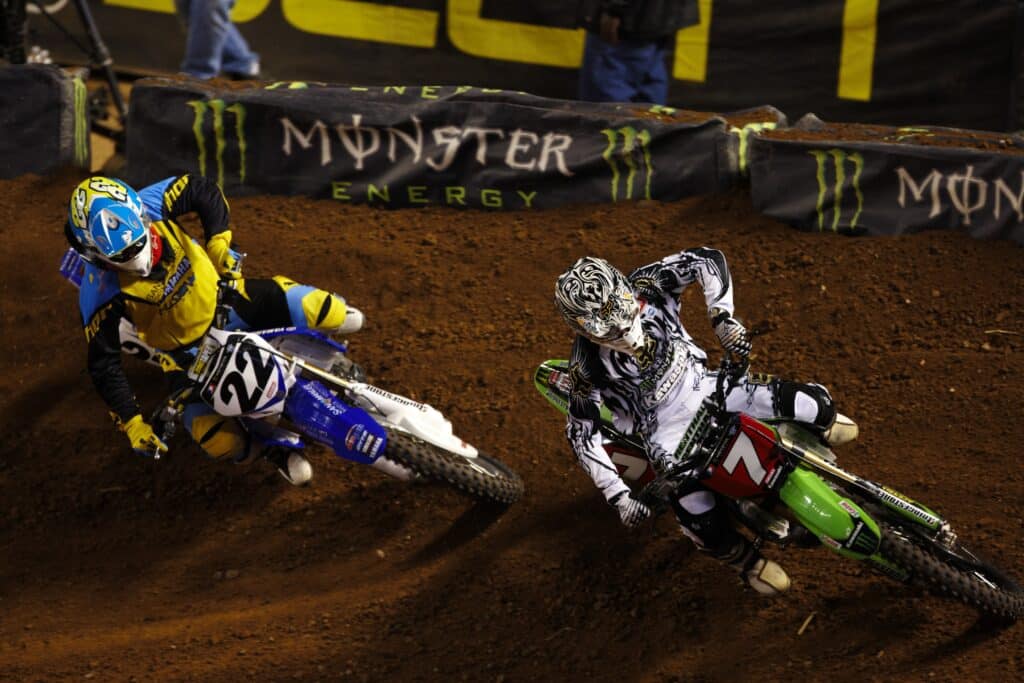
The series returned to Anaheim for round three, a 1986-themed retro race that also featured a track design from that iconic year. The quirky, peaked wall jumps were murder on his knee. Still, he finished both qualifying sessions second to Reed (but 1.4 seconds behind in session two). He knew then that he was done.
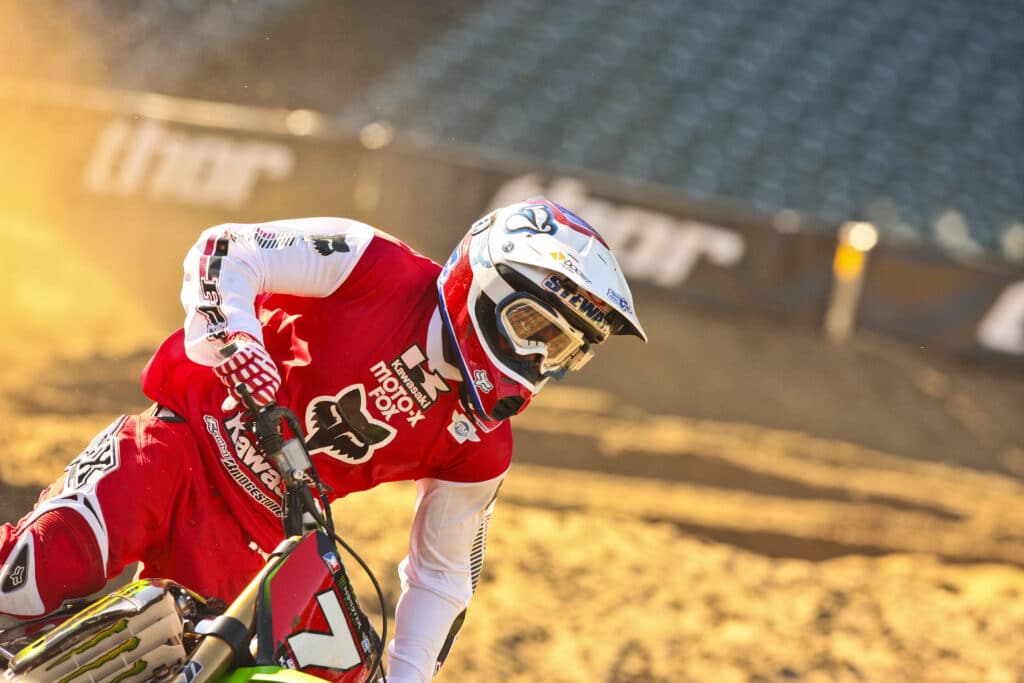
One hour before opening ceremonies, Stewart dropped the shocking news: “I’ve been trying to suck it up every weekend but every weekend it’s getting worse and worse… my knee feels really unstable and it’s to the point there’s nothing I can do about it except for get it fixed.”

Yet again, he was leaving a championship on the table while leading. This time he was tied with Reed.
He had already done the calendar calculation; if he got it fixed now, in late January, then maybe he could still be ready to compete in Pro Motocross at Glen Helen on May 25.

Four days later, an orthopedic surgeon in California sliced out a tendon from Stewart’s own hamstring and used it to replace the torn anterior cruciate ligament in his left knee.
The 2008 Pro Motocross Championship started in four months and three days.
Artwork from We Went Fast
Silly Season Rumors
It’s notable to mention here, before the gates dropped at Glen Helen, a terribly kept secret spread throughout the industry: Stewart was headed to San Manuel L&M Yamaha in 2009 and Chad Reed was out of a ride at the very team for whom he had just won the Supercross title.

Like Carmichael’s signing with Suzuki before the ‘04 Pro Motocross season started, Stewart’s departure from Kawasaki for the ‘09 racing season was also done before the ‘08 MX season commenced. And his rumored new team raced only Supercross.
Stewart didn’t speak about it until he completed his obligations to his current employer. When he did open up, he said Kawasaki simply never made him an offer. In 2022, long after retirement, he re-iterated the story, but in more detail, on his Bubba’s World podcast. “I got fired without knowing I got fired. I didn’t leave Kawasaki. They didn’t re-hire me.”

James Stewart Gets “Off The Couch”
“It’s good to come off the couch and get a first win,” Stewart told Erin Bates from the podium after moto one at the 2008 Glen Helen Pro Motocross. He said it again at the 12th and final round at Steel City Raceway. It was possibly a motivational catchphrase, like saying out loud something he couldn’t believe himself.
Working with Baker meant very little time sitting on an actual couch, but he truthfully didn’t start riding a dirt bike again until three weeks before round one. Exactly four years earlier, Baker brought Ricky Carmichael back from a knee injury in a similar situation where they missed the Supercross season, returned at Pro Motocross Round 1, and won all 24 motos. It was even a left knee, if that matters.
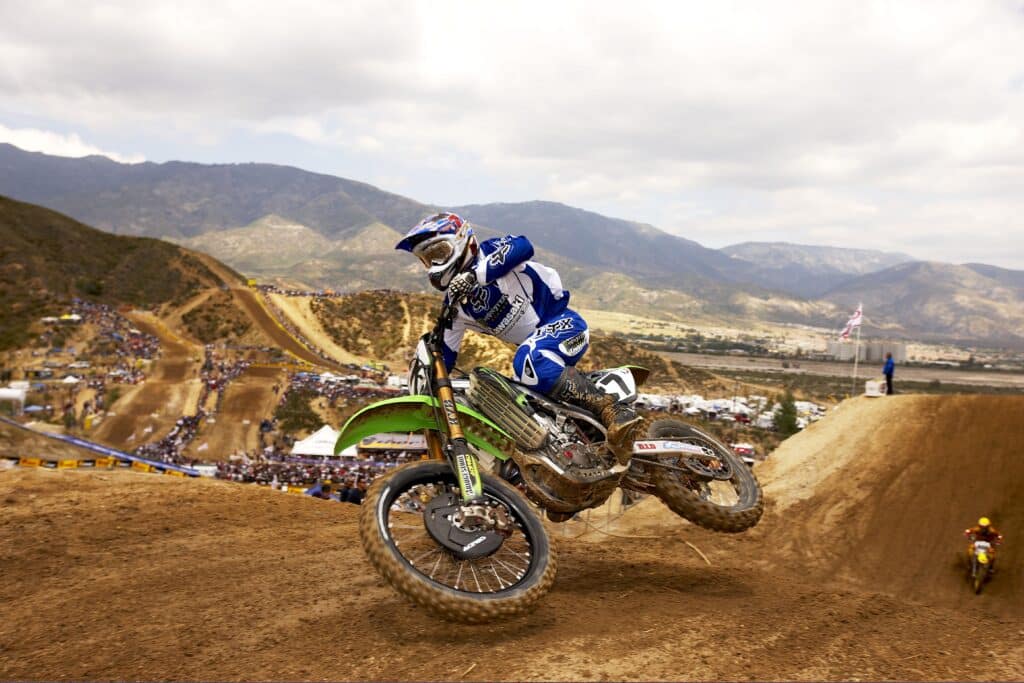
“But every human is different,” Baker says. Experience is valuable but it only goes so far and he was also just two to three months into this new working relationship. With Carmichael, they had already been together for years.
“When [Stewart] first contacted me,” Baker says, “the first thing I thought was, ‘Here’s a guy that I know has the most talent I’ve ever seen, for sure. But what about the work ethic? What about the rest of the commitment?’ Stew had every potential to win everything, but he was volatile. He could go out there and push that limit more than what he should. And it could be over.”

With six fewer weeks to prepare Stewart than he had for Carmichael’s return to racing, Baker went to work on getting mobility back. They knew they would be cutting it close. “There’s never enough time to recover and prepare,” Baker says.
Stewart’s knee responded well and Baker said Stewart stayed focused, determined and worked diligently.

Glen Helen: James Stewart (and many others) Return
So many riders were injured in 2008 that Supercross entry lists got very thin. Some races had as few as 31, 33, and 35 total riders in qualifying.
The Pro Motocross opener featured a long list of returning-from-injury riders. Stewart was the most notable but also back on the line at Glen Helen was Mike Alessi, Ivan Tedesco, Ben Townley and Michael Byrne, who had all returned from broken collarbones, hands, heels and knees.

Conspicuously still absent was Grant Langston, the defending champion. Langston broke his right collarbone three weeks earlier but before that, he spent months dealing with an ongoing eye issue that took him out of the Supercross series. Fluid leaking from behind his eye caused his vision to blur. And it wasn’t improving.
Langston never raced a single lap that summer, thus, for the third time in his career, never got the chance to run a number one plate in motocross (after his 2000 MX2 title he moved to America, after the 2003 AMA 125MX title, he moved to the 250/450 class).

On an unseasonably cool day (jackets and winter hats cold!), Stewart led every single lap of both motos, dominating so convincingly, he made all the riders mentioned above wonder why they returned at all.
In the opening moto of the season Stew’s first five laps were faster than any other rider’s fastest lap. Even coasting at the end, he still won by 16.8 seconds.
James Stewart’s 2008 450MX Season Overview
*Scroll left for more info. n/a = no data available.
Here We Go Again…
At the Hangtown Motocross Classic one week later, the track ran in reverse direction for the first time ever. Stewart holeshot and left the pack behind. The one moment of excitement was when he survived cross-rutting a jump; the rear end of the bike drifted sideways while the front end dove straight down. His suspension absorbed the awkward landing and he tapped into his training to muscle everything back into place.
He rode on as if nothing had happened.
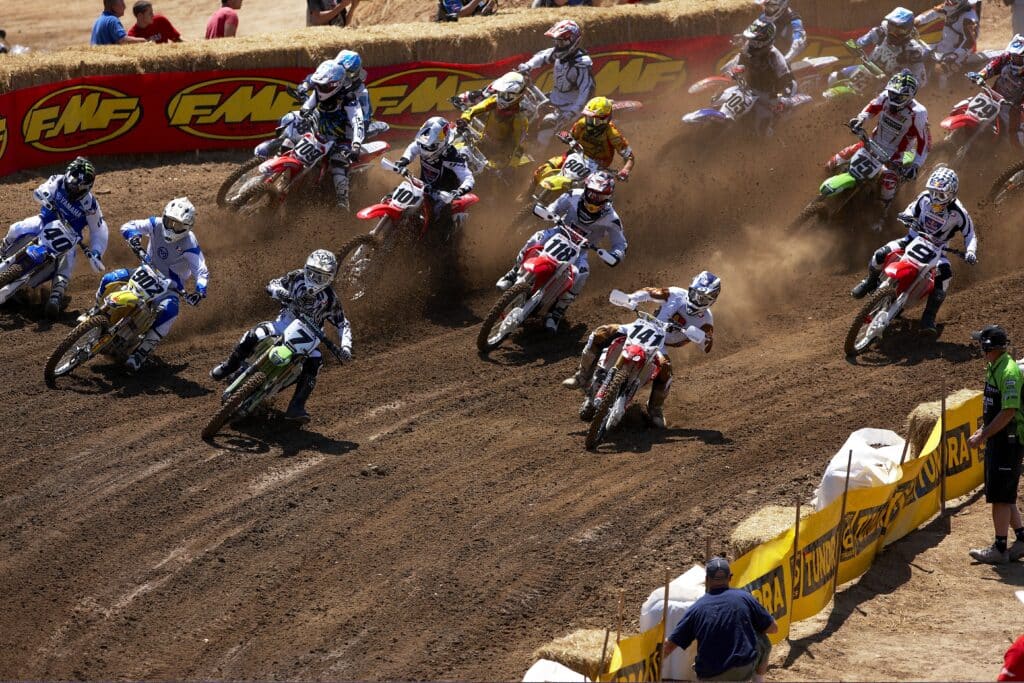
In moto two, Stewart came out of the first corner third and quickly passed Ivan Tedesco. At the top of a long downhill, he yanked a tear-off, drag raced Davi Millsaps to the bottom and went around him on the outside. For the second race in a row, he led every single lap but, more importantly, for the first time in his career he won two consecutive 450MX overalls.

Round three at Freestone Raceway in Wortham, Texas was the first event to run in real heat. The temperature hit 93 by the first 450 gate drop but for Stewart, it felt like another day at home in Haines City, Florida.

Alessi led the first five laps of moto one, which ended up being the most consecutive laps anyone not named James Stewart led all season. Even though he had to pass Alessi twice (Stewart fell on lap one), he still won by 18 seconds.
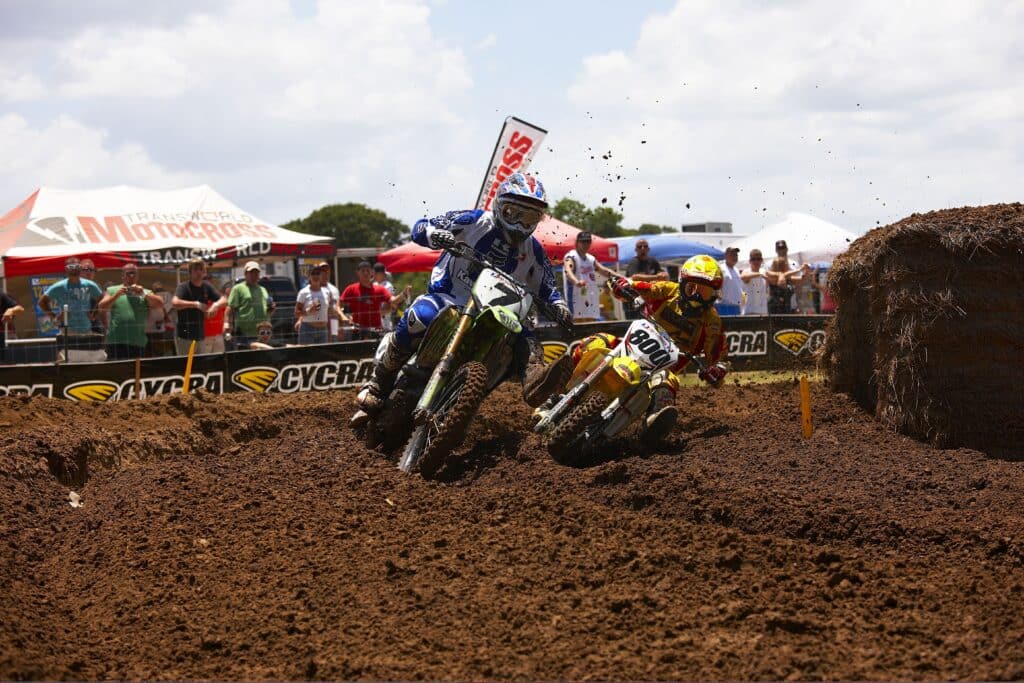
By this point in the summer, Stewart was already looking for ways to challenge himself, like trying to turn two distantly placed sand rollers into a double jump. And he did it while passing Millsaps. He landed brutally hard but still made the pass.
“[I wanted to] make it good for TV and that’s exactly what I did,” Stewart said months after the season ended. “When I came up short I was laughing. That got me all pumped up. I was excited. I said, ‘let’s go chase Alessi’”.

Alessi continued to be the only rider to prevent #7 from streaking across the lap chart table. Stewart led 31 of 32 laps at High Point and 29 of 32 at Thunder Valley where moto two ran live on SPEED TV and at night under the lights.
James Stewart 2008 450MX Laps Led by Race
RedBud and the Start of a Second Streak
The AMA official didn’t want to hear Mike Williamson’s excuses about setting sag or waiting on his rider to emerge from a motorhome; the #7 Kawasaki (along with its rider) arrived late and violated the new-for-2008 staging area regulation: riders and their bikes had to be in the corral 10 minutes before gate drop.
Stewart, who earned number one gate pick for being fastest qualifier (1.1s faster than Alessi), had forfeited his gate position. But he wasn’t alone; Andrew Short also showed up late. They selected their gates after the 38 other riders.

Williamson, who took over as Stewart’s mechanic in May 2007, laughs about the irony of the situation given that Kawasaki was the team parked closest to the starting line. He took a verbal thrashing from “Big” James Stewart Sr.
“Lesson learned,” Williamson says. “I was the first person in the staging area for the rest of the year.”
In 2024, that cutoff time is 20 minutes before race start.
It didn’t make much of a difference. Stewart was third coming out of the second corner. On lap two, he made an aggressive pass on the leader (Alessi, of course), through a steep-banked right-handed sweeper that nearly forced Alessi off the track. They didn’t touch but Stewart came in hot and hard. He won by ‘only’ 12.2 seconds.
James Stewart’s 2008 450MX Victory Margins
Stewart didn’t think much of the pass until his mother advised him to apologize for getting too close. On the starting line, Alessi and Stewart found themselves gated right next to each other. In a 2008 Racer X Show podcast, Stewart said he leaned over to say ‘sorry’ to Alessi but unexpectedly got an earful. “You try to take me out every time,” Stewart said he remembers Alessi chirping.

Alessi may have been trying to remind Stewart of the aggressive pass from moto 2 at Thunder Valley.
“I don’t know if he was trying to intimidate me or make me afraid of him but it didn’t work out,” Stewart said. It was enough motivation for Stewart to tell himself he just needed to get the holeshot, which he did.
Then Alessi’s season ended.
After whipping his RM-Z 450 down RedBud’s ‘sky jump’, Alessi swapped violently in the ruts at the bottom. His body was thrown and rolled up and over a rise. He laid motionless while a half dozen of his peers ran over top of him.
Officials red-flagged the race while the medical crew fitted Alessi to a backboard.
His departure – because of a concussion, broken scapula and broken ribs – was a blow to the series. He had taken eight holeshots within the first 11 motos of the season and was the only rider other than Stewart to lead a lap.
When asked for an interview to discuss racing with Stewart, Alessi politely declined: “I don’t have much to talk about the 2008 season.”
Stewart was now completely unchecked and unchallenged and he led every single lap for the rest of the season. His legendary (and still standing) record of 221 consecutive laps led started on lap two at Red Bud and ended two months later in Delmont, Pennsylvania, when he crossed the line at Steel City Raceway, completing the third perfect 24-0 season in Pro Motocross history.
450MX All-Time Consecutive Laps Led
The laps led streak was resurrected in 2023 when Jett Lawrence strung together a streak of 105 consecutive laps led and then got close to 100 two more times.
Surviving Unadilla
Although it was perfect on paper, Stewart still had a few bumps through the back half of ‘08. The biggest, by far, was simply surviving round eight at Unadilla, which had been (very) unkind to him in his 450MX career. In his first three 450MX attempts (2005-2007) he didn’t complete the day; he crashed out of either the motos or qualifying.

Which explains why, in 2008, when he crossed the finish line just six seconds ahead of New Zealand’s Cody Cooper(!?), he kicked and stomped on the ground and yelled in a gladiator-like manner. He had finally conquered the place, even though it tried its best to derail his day with a lightning storm and pouring rain throughout the second moto, where riders were so much slower overall, they completed three fewer laps than in the first moto.
Stewart had a fall in moto two and Cooper stayed close enough to deny the leader time to relax.
I didn’t want to say this before but… this track scares me.
–James Stewart, 2008 Unadilla podium

Championship: Goal Achieved
With 475 points, Stewart clinched the championship after moto one at Spring Creek. Tim Ferry, Stewart’s Kawasaki teammate, had 325 points. With five motos left to run, Stewart had already scored 36 more points than 2007 champion, Grant Langston scored all season. And if the perfect season was on his mind in moto two, he didn’t show it.

The ultimate goal – the championship – had been completed. The fun began on the starting line for moto two, where he wore a jersey with a giant #1 on the back. Ferry made a joke about how he was going to protest Stewart for the breach of regulation (This is only allowed in special circumstances, such as this, and needs to be approve by the race director).
Then, Stewart completely uncorked anything that he’d bottled up in preservation to focus on winning the title. Thinking back to January and the surgery, he genuinely thought 2008 was going to be “another crappy year”. But now the mission had been accomplished. He could race for himself and he beat Michael Byrne by 1:10.724 (over 70 seconds!).

“It was kind of cool just to hang it out and not really have anything… You know… So what? If I fall, I fall,” he said in an interview after the race.
For Williamson, the mechanic, the motos that followed the championship only got more stressful. “All everybody was talking about is if you could go 24-0, so it was kind of like, we won the championship but we’re not really done. You didn’t get to relax at all. It keeps you up at night a little bit more. Did I do this? Did I do that? Can I do this? Can I do that? You’re just trying to over-prepare.”

24-0
Heavy rain was predicted to slam into the Pittsburgh area and soak Steel City Raceway on Labor Day weekend, 2008. The inclement weather never arrived. Notably, the final round of 2008 was also the trial run of the single day, Saturday format used presently.

Stewart led all 30 laps but his own teammate, Tim Ferry, tried his best to kill the streak, setting the fastest lap of the race (on lap 14!). In fact, laps 11-14 were all faster than Stewart but by that point in the race, he was in management mode.
Ferry finished 5.595 seconds behind and Stewart completed the third perfect season in Pro Motocross history.

“I didn’t want to get to 23-0 and then blow it,” he said in the post-race press conference. “Yeah, I was a little nervous.”

James Stewart All-Time MX Ranks
Frozen in Time
Because L&M Yamaha raced only Supercross, Stewart’s laps led, moto wins and overall streaks ended after the perfect season. On May 2, 2009, he won his second Monster Energy Supercross Championship. That same month, Chris Palmer released a feature story on Stew for ESPN The Magazine.
“I’ve never been afraid of anybody, and I will ride on the edge if I have to,” Stewart told Palmer. “Honestly, I don’t think people want to deal with what it takes to beat me. Nobody is willing to go to that level.”
It’s true. And even though Stewart never won another championship, what he continued to do for years afterward is why we still call him the Fastest Man On The Planet.


